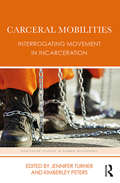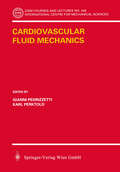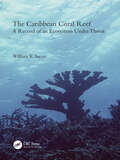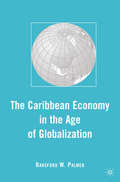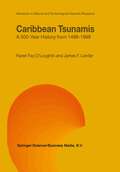- Table View
- List View
Carbonate Microfabrics (Frontiers in Sedimentary Geology)
by Richard Rezak and Dawn L. LavoieCarbonate Microfabrics is the first attempt to bring together in one reference the application of microfabric analysis to the solution of problems in the fields of geology, geophysics and geotechnique. This book, the result of a symposium and workshop on carbonate microfabrics, explores the relationship of microfabrics to fundamental properties and processes in carbonates. Carbonate Microfabrics will be of particular interest to geologists and is intended to be of general interest to researchers in such related fields as geochemistry, geophysics, and geotechnique.
Carbonate Mud-Mounds: Their Origin and Evolution (International Association Of Sedimentologists Series #42)
by C. L. V. Monty D. W. J. Bosence P. H. Bridges B. R. PrattThis is the first book to investigate the structure, origin and evolution of carbonate mud-mounds. Mud-mounds are accumulations of biogenic carbonate sediment that are common in the geological record, and economically important as they host lead zinc mineralization and oil and gas. The book reviews, for the first time, the different mechanisms of mud-mound formation and examines in detail the major changes in mud-mound type and occurrence through geological time. The major part of the book contains case studies of mud-mounds from the Palaeozoic, Mesozoic and Cenozoic. The coverage is global and truly international, with 32 authors from 10 countries. The first volume to deal with the structure, formation and evolution of mud-mounds. Copiously illustrated, with nine colour plates. If you are a member of the International Association of Sedimentologists, for purchasing details, please see: http://www.iasnet.org/publications/details.asp?code=SP23
Carbonate Petroleum Reservoirs (Casebooks in Earth Sciences)
by Philip W. Choquette Perry O. RoehlThe case history approach has an impressive record of success in a variety of disciplines. Collections of case histories, casebooks, are now widely used in all sorts of specialties other than in their familiar application to law and medicine. The case method had its formal beginning at Harvard in 1871 when Christopher Lagdell developed it as a means of teaching. It was so successful in teaching law that it was soon adopted in medical education, and the col lection of cases provided the raw material for research on various diseases. Subsequently, the case history approach spread to such varied fields as busi ness, psychology, management, and economics, and there are over 100 books in print that use this approach. The idea for a series of Casebooks in Earth Sciences grew from my ex perience in organizing and editing a collection of examples of one variety of sedimentary deposits. The project began as an effort to bring some order to a large number of descriptions of these deposits that were so varied in pre sentation and terminology that even specialists found them difficult to compare and analyze. Thus, from the beginning, it was evident that something more than a simple collection of papers was needed. Accordingly, the nearly fifty contributors worked together with George de Vries Klein and me to establish a standard format for presenting the case histories.
Carbonate Platforms: Facies, Sequences and Evolution (International Association Of Sedimentologists Series #65)
by Paul D. Crevello J. F. Read J. Frederick Sarg James Lee Wilson Maurice E. TuckerThis volume also discusses the computer modelling of carbonate cycles and sequence analysis. This will prove an invaluable text for senior undergraduate and postgraduate students in the earth sciences in general and will also be of value to the professional researcher. Carbonate platforms contains contributions from an international authorship and the volume has been edited by one of the most respected names in the earth sciences. Areas covered include; early rifting deposition; examples from carbonate sequences of Sardinia (Cambrian) and Tuscany (Triassic-Jurassic), Italy; geometry and evolution of platform-margin bioclastic shoals, late Dinantian (Mississippian), Derbyshire, UK; cyclic sedimentation in cabonate and mixed carbonate/clastic environments; four simulation programs for a desktop computer; middle Triassic carbonate ramp systems in the Catalan Basis, N.E. Spain; facies, cycles, depositional sequencies and controls; stages in the evolution of late Triassic and Jurassic platform carbonates; western margin of the Subalpine basin, Ardech, France. The formation and drowning of isolated carbonate platforms; tectonic and ecologic control of the Northern Apennines; controls on Upper Jurassic carbonate build up development in the Lusitanian Basin, Portugal; Hauterivian to Lower Aptian carbonate shelf sedimentation and sequence stratigraphy in the Jura and northern Subalpine chains (southeastern France and Swiss Jura); basement structural controls on Mesozoic carbonate facies in northeastern Mexico; the Aptian-Albian carbonate episode of the Basque-Cantabrian Basis (Northern Spain); general characteristics, controls and evolution; response of the Arabian carbonate platform margin slope to orogenic closing of an ocean basin, Cretaceous, Oman.
Carbonate Reservoir Characterization: An Integrated Approach
by F. Jerry LuciaOne main target in petroleum recovery is the description of of the three-dimensional distribution of petrophysical properties on the interwell scale in carbonate reservoirs, in order to improve performance predictions by means of fluid-flow computer simulations The book focuses on the improvement of geological, petrophysical, and geostatistical methods, describes the basic petrophysical properties, important geology parameters, and rock fabrics from cores, and discusses their spatial distribution. A closing chapter deals with reservoir models as an input into flow simulators.
Carbonate Reservoir Characterization: An Integrated Approach
by F. Jerry LuciaF. Jerry Lucia, working in America’s main oil-rich state, has produced a work that goes after one of the holy grails of oil prospecting. One main target in petroleum recovery is the description of the three-dimensional distribution of petrophysical properties on the interwell scale in carbonate reservoirs. Doing so would improve performance predictions by means of fluid-flow computer simulations. Lucia’s book focuses on the improvement of geological, petrophysical, and geostatistical methods, describes the basic petrophysical properties, important geology parameters, and rock fabrics from cores, and discusses their spatial distribution. A closing chapter deals with reservoir models as an input into flow simulators.
Carbonate Reservoir Heterogeneity: Overcoming the Challenges (SpringerBriefs in Petroleum Geoscience & Engineering)
by Vahid TavakoliThis book provides a comprehensive overview of the parameters and factors that cause heterogeneity in carbonate reservoirs, and examines how they interact with one another. It explores the various scales of heterogeneity, how they are caused, and how they can be minimized, as well as how the scales affect each other, providing practical examples in each chapter. The book concludes by discussing the effect of heterogeneity on petrophysical evaluations. As reducing heterogeneity is the only way to obtain accurate carbonate reservoir characteristics at the regional scale, the book offers an important reference guide for all geologists, engineers, and modelers working with subsurface data.
Carbonate Sedimentology
by Maurice E. Tucker V. Paul WrightCarbonate rocks (limestones and dolomites) constitute a major part of the geological column and contain not only 60% of the world's known hydrocarbons but also host extensive mineral deposits. This book represents the first major review of carbonate sedimentology since the mid 1970's. It is aimed at the advanced undergraduate - postgraduate level and will also be of major interest to geologists working in the oil industry. Carbonate Sedimentology is designed to take the reader from the basic aspects of limestone recognition and classification through to an appreciation of the most recent developments such as large scale facies modelling and isotope geochemistry. Novel aspects of the book include a detailed review of carbonate mineralogy, non-marine carbonate depositional environments and an in-depth look at carbonate deposition and diagenesis through geologic time. In addition, the reviews of individual depositional systems stress a process-based approach rather than one centered on simple comparative sedimentology. The unique quality of this book is that it contains integrated reviews of carbonate sedimentology and diagenesis, within one volume.
Carbonate Systems During the Olicocene-Miocene Climatic Transition (International Association Of Sedimentologists Series #107)
by Maria Mutti Werner Piller Christian BetzlerThe Oligocene and Miocene Epochs comprise the most important phases in the Cenozoic global cooling that led from a greenhouse to an icehouse Earth. Recent major advances in the understanding and time-resolution of climate events taking place at this time, as well as the proliferation of studies on Oligocene and Miocene shallow-water/neritic carbonate systems, invite us to re-evaluate the significance of these carbonate systems in the context of changes in climate and Earth surface processes. Carbonate systems, because of a wide dependence on the ecological requirements of organisms producing the sediment, are sensitive recorders of changes in environmental conditions on the Earth surface. The papers included in this Special Publication address the dynamic evolution of carbonate systems deposited during the Oligocene and Miocene in the context on climatic and Earth surfaces processes focusing on climatic trends and controls over deposition; temporal changes in carbonate producers and palaeoecology; carbonate terminology; facies; processes and environmental parameters (including water temperature and production depth profiles); carbonate producers and their spatial and temporal variability; and tectonic controls over architecture. This book is part of the International Association of Sedimentologists (IAS) Special Publications. The Special Publications from the IAS are a set of thematic volumes edited by specialists on subjects of central interest to sedimentologists. Papers are reviewed and printed to the same high standards as those published in the journal Sedimentology and several of these volumes have become standard works of reference.
Carbonate Systems During the Olicocene-Miocene Climatic Transition (International Association Of Sedimentologists Series)
by Maria Mutti Werner E. Piller Christian BetzlerThe Oligocene and Miocene Epochs comprise the most important phases in the Cenozoic global cooling that led from a greenhouse to an icehouse Earth. Recent major advances in the understanding and time-resolution of climate events taking place at this time, as well as the proliferation of studies on Oligocene and Miocene shallow-water/neritic carbonate systems, invite us to re-evaluate the significance of these carbonate systems in the context of changes in climate and Earth surface processes. Carbonate systems, because of a wide dependence on the ecological requirements of organisms producing the sediment, are sensitive recorders of changes in environmental conditions on the Earth surface. The papers included in this Special Publication address the dynamic evolution of carbonate systems deposited during the Oligocene and Miocene in the context on climatic and Earth surfaces processes focusing on climatic trends and controls over deposition; temporal changes in carbonate producers and palaeoecology; carbonate terminology; facies; processes and environmental parameters (including water temperature and production depth profiles); carbonate producers and their spatial and temporal variability; and tectonic controls over architecture. This book is part of the International Association of Sedimentologists (IAS) Special Publications. The Special Publications from the IAS are a set of thematic volumes edited by specialists on subjects of central interest to sedimentologists. Papers are reviewed and printed to the same high standards as those published in the journal Sedimentology and several of these volumes have become standard works of reference.
Carbonatite Volcanism: Oldoinyo Lengai and the Petrogenesis of Natrocarbonatites (IAVCEI Proceedings in Volcanology #4)
by JörgKeller KeithBellDuring the last few years, carbonatites have received a considerable amount of attention. Some of this interest was no doubt kindled by the importance of volatiles in the Earth's mantle, particularly CO , by the fact that carbonatites 2 can be used to monitor the chemical evolution of the sub-continental upper mantle, and by the fact that carbonatites may be effective metasomatizing agents at both mantle and crustal levels. The interest in Oldoinyo Lengai has extended over at least 100 years, but it was not until the eruptions of 1960, when the unique carbonatitic nature of its lavas was recognized, that the volcano took on special significance in volcanology and igneous petrology. The recognition of carbonatitic flows coin cided with the first successful laboratory experiments carried out on carbonatitic melts. Since then, Oldoinyo Lengai has formed a cornerstone in all carbonatite discussions. It is probably true to say that the findings from Oldoinyo Lengai have dominated our ideas about carbonatites, in spite of the fact that the alkali rich, natrocarbonatitic lavas of Oldoinyo Lengai are markedly different from other carbonatites.
Carceral Geography: Spaces and Practices of Incarceration
by Dominique MoranThe ’punitive turn’ has brought about new ways of thinking about geography and the state, and has highlighted spaces of incarceration as a new terrain for exploration by geographers. Carceral geography offers a geographical perspective on incarceration, and this volume accordingly tracks the ideas, practices and engagements that have shaped the development of this new and vibrant subdiscipline, and scopes out future research directions. By conveying a sense of the debates, directions, and threads within the field of carceral geography, it traces the inner workings of this dynamic field, its synergies with criminology and prison sociology, and its likely future trajectories. Synthesizing existing work in carceral geography, and exploring the future directions it might take, the book develops a notion of the ’carceral’ as spatial, emplaced, mobile, embodied and affective.
Carceral Geography: Spaces and Practices of Incarceration (Palgrave Studies In Prisons And Penology Ser.)
by Dominique MoranThe ’punitive turn’ has brought about new ways of thinking about geography and the state, and has highlighted spaces of incarceration as a new terrain for exploration by geographers. Carceral geography offers a geographical perspective on incarceration, and this volume accordingly tracks the ideas, practices and engagements that have shaped the development of this new and vibrant subdiscipline, and scopes out future research directions. By conveying a sense of the debates, directions, and threads within the field of carceral geography, it traces the inner workings of this dynamic field, its synergies with criminology and prison sociology, and its likely future trajectories. Synthesizing existing work in carceral geography, and exploring the future directions it might take, the book develops a notion of the ’carceral’ as spatial, emplaced, mobile, embodied and affective.
Carceral Mobilities: Interrogating Movement in Incarceration (Routledge Studies in Human Geography)
by Jennifer Turner Kimberley PetersMobilities research is now centre stage in the social sciences with wide-ranging work that considers the politics underscoring the movements of people and objects, critically examining a world that is ever on the move. At first glance, the words ‘carceral’ and ‘mobilities’ seem to sit uneasily together. This book challenges the assumption that carceral life is characterised by a lack of movement. Carceral Mobilities brings together contributions that speak to contemporary debates across carceral studies and mobilities research, offering fresh insights to both areas by identifying and unpicking the manifold mobilities that shape, and are shaped by, carceral regimes. It features four sections that move the reader through the varying typologies of motion underscoring carceral life: tension; circulation; distribution; and transition. Each mobilities-led section seeks to explore the politics encapsulated in specific regimes of carceral movement. With contributions from leading scholars, and a range of international examples, this book provides an authoritative voice on carceral mobilities from a variety of perspectives, including criminology, sociology, history, cultural theory, human geography, and urban planning. This book offers a first port of call for those examining spaces of detention, asylum, imprisonment, and containment, who are increasingly interested in questions of movement in relation to the management, control, and confinement of populations.
Carceral Mobilities: Interrogating Movement in Incarceration (Routledge Studies in Human Geography)
by Jennifer Turner Kimberley PetersMobilities research is now centre stage in the social sciences with wide-ranging work that considers the politics underscoring the movements of people and objects, critically examining a world that is ever on the move. At first glance, the words ‘carceral’ and ‘mobilities’ seem to sit uneasily together. This book challenges the assumption that carceral life is characterised by a lack of movement. Carceral Mobilities brings together contributions that speak to contemporary debates across carceral studies and mobilities research, offering fresh insights to both areas by identifying and unpicking the manifold mobilities that shape, and are shaped by, carceral regimes. It features four sections that move the reader through the varying typologies of motion underscoring carceral life: tension; circulation; distribution; and transition. Each mobilities-led section seeks to explore the politics encapsulated in specific regimes of carceral movement. With contributions from leading scholars, and a range of international examples, this book provides an authoritative voice on carceral mobilities from a variety of perspectives, including criminology, sociology, history, cultural theory, human geography, and urban planning. This book offers a first port of call for those examining spaces of detention, asylum, imprisonment, and containment, who are increasingly interested in questions of movement in relation to the management, control, and confinement of populations.
Carceral Space, Prisoners and Animals (Routledge Human-Animal Studies Series)
by Karen M. MorinCarceral Space, Prisoners and Animals explores resonances across human and nonhuman carceral geographies. The work proposes an analysis of the carceral from a broader vantage point than has yet been done, developing a ‘trans-species carceral geography’ that includes spaces of nonhuman captivity, confinement, and enclosure alongside that of the human. The linkages across prisoner and animal carcerality that are placed into conversation draw from a number of institutional domains, based on their form, operation, and effect. These include: the prison death row/ execution chamber and the animal slaughterhouse; sites of laboratory testing of pharmaceutical and other products on incarcerated humans and captive animals; sites of exploited prisoner and animal labor; and the prison solitary confinement cell and the zoo cage. The relationships to which I draw attention across these sites are at once structural, operational, technological, legal, and experiential / embodied. The forms of violence that span species boundaries at these sites are all a part of ordinary, everyday, industrialized violence in the United States and elsewhere, and thus this ‘carceral comparison’ amongst them is appropriate and timely.
Carceral Space, Prisoners and Animals (Routledge Human-Animal Studies Series)
by Karen M. MorinCarceral Space, Prisoners and Animals explores resonances across human and nonhuman carceral geographies. The work proposes an analysis of the carceral from a broader vantage point than has yet been done, developing a ‘trans-species carceral geography’ that includes spaces of nonhuman captivity, confinement, and enclosure alongside that of the human. The linkages across prisoner and animal carcerality that are placed into conversation draw from a number of institutional domains, based on their form, operation, and effect. These include: the prison death row/ execution chamber and the animal slaughterhouse; sites of laboratory testing of pharmaceutical and other products on incarcerated humans and captive animals; sites of exploited prisoner and animal labor; and the prison solitary confinement cell and the zoo cage. The relationships to which I draw attention across these sites are at once structural, operational, technological, legal, and experiential / embodied. The forms of violence that span species boundaries at these sites are all a part of ordinary, everyday, industrialized violence in the United States and elsewhere, and thus this ‘carceral comparison’ amongst them is appropriate and timely.
Carceral Spaces: Mobility and Agency in Imprisonment and Migrant Detention
by Nick GillThis book draws together the work of a new community of scholars with a growing interest in carceral geography: the geographical study of practices of imprisonment and detention. It combines work by geographers on 'mainstream' penal establishments where people are incarcerated by the prevailing legal system, with geographers' recent work on migrant detention centres, where irregular migrants and 'refused' asylum seekers are detained, ostensibly pending decisions on admittance or repatriation. Working in these contexts, the book's contributors investigate the geographical location and spatialities of institutions, the nature of spaces of incarceration and detention and experiences inside them, governmentality and prisoner agency, cultural geographies of penal spaces, and mobility in the carceral context. In dialogue with emergent and topical agendas in geography around mobility, space and agency, and in relation to international policy challenges such as the (dis)functionality of imprisonment and the search for alternatives to detention, this book presents a timely addition to emergent interdisciplinary scholarship that will prompt dialogue among those working in geography, criminology and prison sociology.
Carceral Spaces: Mobility and Agency in Imprisonment and Migrant Detention
by Nick GillThis book draws together the work of a new community of scholars with a growing interest in carceral geography: the geographical study of practices of imprisonment and detention. It combines work by geographers on 'mainstream' penal establishments where people are incarcerated by the prevailing legal system, with geographers' recent work on migrant detention centres, where irregular migrants and 'refused' asylum seekers are detained, ostensibly pending decisions on admittance or repatriation. Working in these contexts, the book's contributors investigate the geographical location and spatialities of institutions, the nature of spaces of incarceration and detention and experiences inside them, governmentality and prisoner agency, cultural geographies of penal spaces, and mobility in the carceral context. In dialogue with emergent and topical agendas in geography around mobility, space and agency, and in relation to international policy challenges such as the (dis)functionality of imprisonment and the search for alternatives to detention, this book presents a timely addition to emergent interdisciplinary scholarship that will prompt dialogue among those working in geography, criminology and prison sociology.
Cardiovascular Fluid Mechanics (CISM International Centre for Mechanical Sciences #446)
by Gianni Pedrizzetti Karl PerktoldThe book presents the state of the art in the interdisciplinary field of fluid mechanics applied to cardiovascular modelling. It is neither a monograph nor a collection of research papers, rather an extended review in the field. It is arranged in 4 scientific chapters each presenting thoroughly the approach of a leading research team; two additional chapters prepared by biomedical scientists present the topic by the applied perspective. A unique feature is a substantial (approx. one fourth of the book) medical introductory part, written by clinical researchers for scientific readers, that would require a large effort to be collected otherwise.
The Caribbean Coral Reef: A Record of an Ecosystem Under Threat
by William K. SaccoThis book is a visual tour of Caribbean coral reefs between 1968 and 1978. They are the world’s second largest coral reef community and the most threatened. The Caribbean Coral Reef: A Record of an Ecosystem Under Threat offers a priceless historical record made by a photographer who set out to document the major reef species when those reefs were at their prime. Today, coral reefs are under threat as never before and, sadly, most of what is shown in the book's photographs is now gone forever. It is only by comparing the images in this book with what we see now that we are able to fully recognize what we have lost. With its stunning photography and precise, accurate scientific information, this book offers students of coral reefs a wealth of information about this rich, fragile ecosystem. It is also written accessibly for non-academic visitors to the Caribbean reef or anyone interested in the earth’s creatures. Many of the invertebrates will be unfamiliar to most people, and the author reveals fascinating insights into these otherworldly creatures and their lifestyles. Enjoy this field guide to the reefs that were, and savor the beauty of this vanishing environment and its organisms.
The Caribbean Coral Reef: A Record of an Ecosystem Under Threat
by William K. SaccoThis book is a visual tour of Caribbean coral reefs between 1968 and 1978. They are the world’s second largest coral reef community and the most threatened. The Caribbean Coral Reef: A Record of an Ecosystem Under Threat offers a priceless historical record made by a photographer who set out to document the major reef species when those reefs were at their prime. Today, coral reefs are under threat as never before and, sadly, most of what is shown in the book's photographs is now gone forever. It is only by comparing the images in this book with what we see now that we are able to fully recognize what we have lost. With its stunning photography and precise, accurate scientific information, this book offers students of coral reefs a wealth of information about this rich, fragile ecosystem. It is also written accessibly for non-academic visitors to the Caribbean reef or anyone interested in the earth’s creatures. Many of the invertebrates will be unfamiliar to most people, and the author reveals fascinating insights into these otherworldly creatures and their lifestyles. Enjoy this field guide to the reefs that were, and savor the beauty of this vanishing environment and its organisms.
The Caribbean Economy in the Age of Globalization (Early Modern Cultural Studies 1500–1700)
by R. PalmerThe book examines how globalization is altering the structure of the extremely foreign trade-dependent Caribbean economies. It treats these small economies together as a single economy by focusing on their common features.
Caribbean School Atlas Skills Workbook (PDF)
by Michael MorrisseyThe Workbook is suitable for Grades 4-9 and can be used alongside the Hodder Education Caribbean School Atlas.
Caribbean Tsunamis: A 500-Year History from 1498-1998 (Advances in Natural and Technological Hazards Research #20)
by K.F. O'Loughlin James F. LanderCaribbean Tsunamis - A 500-Year History from 1498-1998 broadly characterizes the nature of tsunamis in the Caribbean Sea, while bearing in mind both scientific aspects as well as potential interest by the many governments and populations likely to be affected by the hazard. Comprehension of the nature of tsunamis and past effects is crucial for the awareness and education of populations at risk. Audience: This book provides a thorough, yet highly accessible review of tsunamis in the Caribbean. It is of interest not only to tsunami and natural hazards specialists at academia and governmental institutes, but also to policy makers and to the general public.











